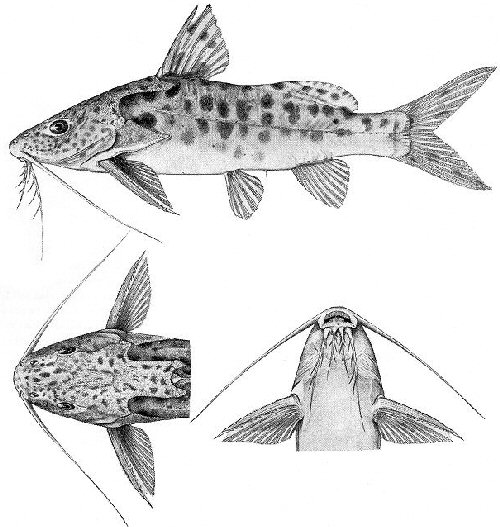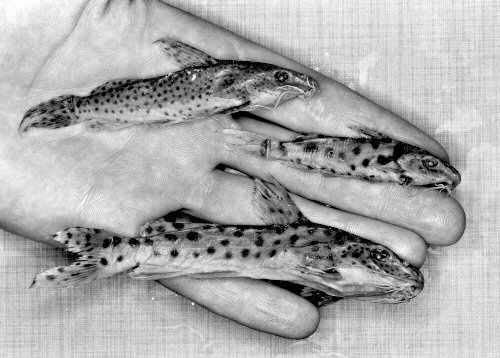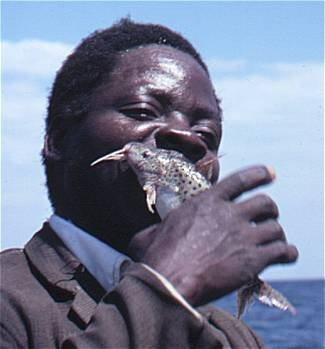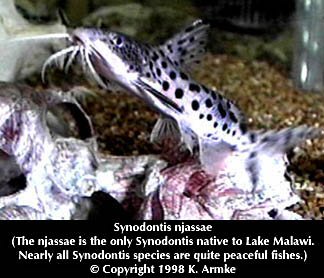SCOTCAT.COM
your internet guide to all things catfish
| Synodontis njassae Keilhack, 1908 |
by Michael K. Oliver, Ph.D. |
Synodontis njassae Keilhack, lecotype, 192mm, Langenburg, lac Nyassa (Inst Spez,. Zool Mus. Berlin No. 18191) (From Poll 1971)
Its colour pattern is quite variable, with some individuals having many small spots, and others having only a few large spots. I collected about 500 specimens during rotenone sampling of rocky shores in 1980, and observed that the spotting variation appeared to be continuous, rather than falling into discrete "large spotted" and "small spotted" forms as many aquarists believe. Specimens with small, medium, and large spots are shown in a black-and-white photograph below. Recently, Snoeks (2004b), without documentation, listed a "Synodontis sp. 2" from Lake Malawi, noting "it is my impression that there is at least one other Synodontis species in the lake." Snoeks did not divulge if his suspicion is based on color pattern, ecology, or something else. Until this hypothetical second species can be substantiated, I continue to regard S. njassae as a single variable species. Synodontis njassae has a strong, sharp, serrated spine at the front of the dorsal fin and each pectoral fin. These spines can be locked at right angles to the body. The fish can also produce defensive squeaking sounds, which are easily audible through an aquarium glass, using its pectoral stridulation mechanism. The mucus covering the spines is apparently toxic. While netting stunned individuals during rotenone sampling, I was nicked on the thumb by the tip of a spine. Within a few seconds, the skin around the nick swelled into a tight, painful, almost hemispherical lump that took a couple of days to disappear; a small scar remains at the site of the puncture over 30 years later.
Specimens of Synodontis njassae with small, medium, and large spots, collected by Geoffrey Fryer in the vicinity of Nkhata Bay and sent to the British Museum (Natural History) in 1957. Photo © M. K. Oliver
Because of these fin spines and its large, bony head, S. njassae (known to the indigenous fishermen as Kolokolo or Njekayeka, both words that probably imitate the squeaking sound the fish makes as just described above, and to Europeans as the Squeaker) is not an important food fish. It is, however, eaten when available. Some fishermen actually bite off the spines to make the fish safe to handle (see photo below left, by M. K. Oliver). .
Biting off the spines to make the fish safe to handle
Biology. The vertical distribution of S. njassae was studied by Thompson, Allison, & Ngatunga (1996a). They sampled offshore fishes at six locations using mid-water trawl and gillnets. I had the impression that this catfish is confined to rocky shores in relatively shallow water. Wrong! Thompson et al. demonstrated that, in fact, it is also abundant in the pelagic zone (in open water, well above the substrate). By day it occurs all the way down to the limits of dissolved oxygen — 230 meters (750 feet), moving up to the surface layers at night. In the southwest arm of Lake Malawi, S. njassae is common at all depths but most abundant in deeper water, constituting (by weight) a mean of 2.0% of the catch of demersal fishes at a depth of 10 m (33 feet), 4.5% at 30 m (98 feet), 3.6% at 50 m (164 feet), 2.8% at 75 m (246 feet), 7.6% at 100 m (330 feet), and 8.5% at 125 m (410 feet) (Duponchelle et al., 2000a). Size: Most individuals captured in open water have a standard length (SL, without caudal fin) of 90 to 110 mm (3½-4.3 inches), but some as small as 50 mm (2 inches) or as large as 200 mm (8 inches) SL were caught. This species attains a maximum length of 30 cm (11.8 inches) (Eccles, 1992). Food: Allison, Irvine, Thompson, & Ngatunga (1996) reported on the diets and food consumption rates of some common offshore pelagic fishes, including S. njassae. This catfish (again, to my surprise) feeds extensively on zooplankton, all day long but more intensively during the night when it is nearer the surface. The predominant food items found in 150 stomachs of S. njassae from open water included the planktonic crustaceans Tropodiaptomus cunningtoni and Mesocyclops a. aequatorialis and the lakefly Chaoborus edulis (fourth instar larvae, adults, and pupae); less frequent food items included planktonic algae (mainly Aulacoseira), other planktonic crustaceans, other insects, and detritus (Allison, Thompson, Ngatunga, & Irvine, 1995, table 9.9). Breeding: Thompson, Allison, Ngatunga, & Bulirani (1995) summarized what is known of the breeding biology of Synodontis njassae. The breeding site within the lake remains unknown. The eggs are tiny (0.16 mg per egg); fecundity is high, with a mean of 1341 eggs per fish (817 females examined). Although some females up to 14 cm (5½ inches) in length were immature, the average size at first maturity was estimated to be 11 cm (4.3 inches) and some females matured at 10 cm (4 inches). In ripe females, the ovaries can attain 8-9% of body weight. The authors found females ready to spawn throughout the year; no seasonality was observed. No larvae or juveniles were found offshore; individuals less than 10 cm (4 inches) in length were rare in the open-water zone. One of the puzzles of speciation in the African rift lakes is why Lake Malawi has only this one Synodontis, while Lake Tanganyika, with a smaller cichlid flock, has evolved a flock of at least 7 endemic species of Synodontis (plus two more widely distributed species).
Image
© 1998 by K. Armke, from Armke's
Rare Aquarium Fish. Used with the kind permission of
Ken Armke
Sources: Reproduced with kind permission of the author from the The Cichlid Fishes of Lake Malawi, Africa Home Page Article at malawicichlids.com
|
If you would like to contribute an article, please e-mail me. You will of course be credited for your work.
If you would like to donate any denomination of money to the site just click the above link button. All proceeds will go to running the site and hopefully to keep it going for a few years yet.
Print or e-mail this article below





